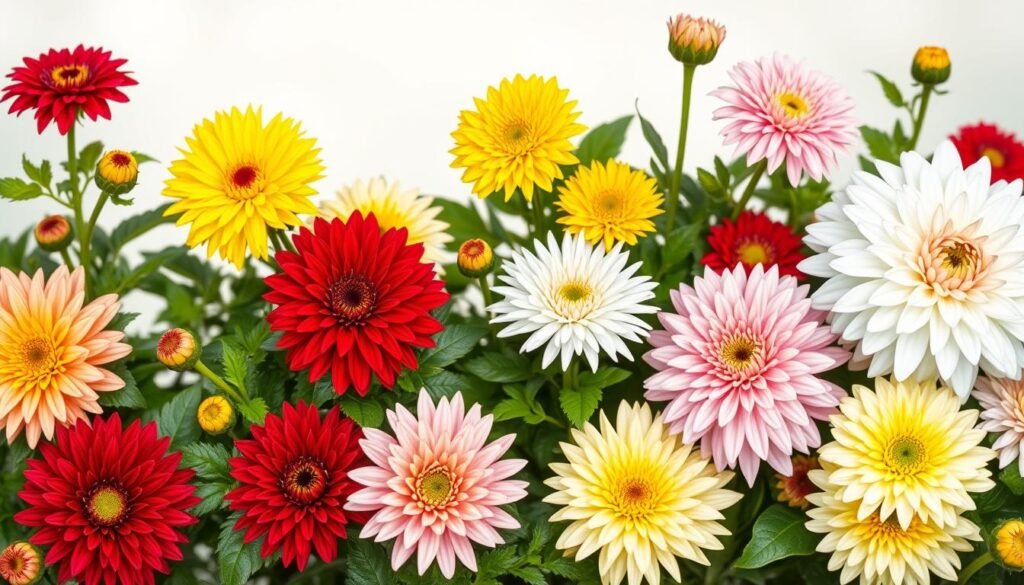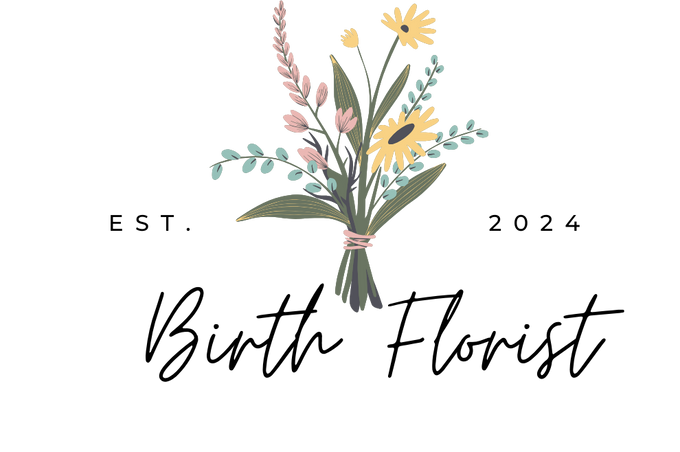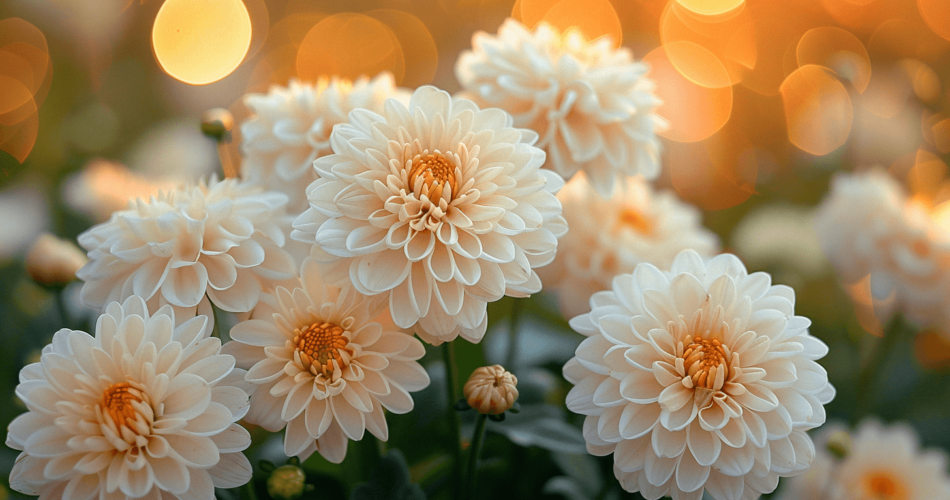Chrysanthemums, or mums, are beautiful flowers with a long history. They have been loved for thousands of years. What is a chrysanthemum flower? It belongs to the Asteraceae family, which has over 23,000 types of flowering plants.
The meaning of chrysanthemum flowers varies by culture. In the U.S., they symbolize joy and optimism. But in some European countries, they are seen as symbols of death. This shows how the flower’s meaning can differ around the world.
Related Post: Birth Flowers for all 12 months

Did you know chrysanthemums are the biggest flower grown in the U.S.? They’re not just for looks. These flowers are also used in cooking and medicine. They can be found in salads and teas, adding flavor and possibly health benefits.
Key Takeaways
- Chrysanthemums belong to the largest flowering plant family
- They symbolize different things in various cultures
- Chrysanthemums are the top commercially produced flower in the U.S.
- These flowers have culinary and medicinal applications
- Chrysanthemums come in a wide range of colors and shapes
What is Chrysanthemum Flower: Botanical Characteristics
Chrysanthemums belong to the Asteraceae family. They are a diverse group of flowering plants with a rich history. These beautiful blooms come in various types, each with unique characteristics.
Origin and Historical Significance
The genus Chrysanthemum includes about 30 species native to Asia and northeastern Europe. Cultivated in China for over 3,000 years, chrysanthemums have played a significant role in many civilizations. In Japan, the flower holds such importance that it became the official seal of the imperial family.
Varieties and Diversity
Chrysanthemums boast an impressive range of varieties, with over 200 species. They include annuals, perennials, and small shrubs. Garden hardy mums are perennials that can survive winter in most northern latitudes.
Exhibition varieties require special care. These flowers come in various colors such as yellow, white, purple, and red. Chrysanthemum × morifolium is the most important commercial hybrid.
Cultural Importance Across Civilizations
The cultural significance of chrysanthemums extends beyond Asia. Introduced to America in the late 1700s, they gained popularity in the early 1900s. Today, chrysanthemums are widely used in gardening, floristry, and even culinary applications.
The Rich History of Chrysanthemums
Chrysanthemums have a long history, starting in ancient China. These flowers have traveled far, changing from medicinal plants to popular garden flowers.
Ancient Chinese Cultivation
In China, people started growing chrysanthemums over 3,000 years ago. At first, they were used for their health benefits. Later, they were loved for their beauty. Gardeners in China created many types of chrysanthemums, which we see today.
Journey from East to West
In the 8th century, chrysanthemums reached Japan and became a favorite of the royal family. They made their way to Europe in the 1700s, thanks to Dutch explorers. By the late 1700s, they arrived in America, with Colonel John Stevens bringing a rare variety.
Modern-day Popularity
Now, chrysanthemums are almost as popular as roses worldwide. The Chrysanthemum Society of America, started in 1902, recognizes 13 types. These include the Irregular Incurve and the Spider, offering many shapes and colors for gardens and flower arrangements.
- Anemone
- Pompom
- Regular incurve
- Single or daisy
- Spider
This history has turned a simple herb into a symbol of beauty and royalty around the globe.
Symbolism and Cultural Significance
Chrysanthemums hold different meanings in various cultures. In Japan, they are especially revered. The country celebrates National Chrysanthemum Day, a tradition since 910 AD. The Imperial Seal of Japan also features the chrysanthemum, showing its royal significance.
The meaning of chrysanthemums changes with the culture. In China and Japan, they are enjoyed in chrysanthemum wine during the Double Ninth Festival. But in Western Europe, they are often seen in mourning arrangements. White and yellow chrysanthemums are common in funeral flowers in both Asia and Europe.
Chrysanthemums also have practical uses. In traditional Chinese medicine, they help with fever, inflammation, and eye health. Yellow chrysanthemums need full sunlight and well-draining soil to grow well. To promote bushy growth and more blooms, pinch back stems and remove spent flowers.
| Color | Symbolism | Cultural Context |
|---|---|---|
| White | Grief, lamentation | Japan, Korea, China, Western Europe |
| Yellow | Happiness, well-wishes | Western cultures |
| Yellow | Mourning | Korea, China, Japan |
Chrysanthemum Colors and Their Meanings
Chrysanthemum flowers come in a wide range of colors, each with its own special meaning. These flowers are loved in gardens and flower arrangements all over the world. They are also the biggest flower grown for sale in the United States.
Traditional Color Symbolism
Chrysanthemum colors have deep meanings in different cultures. White chrysanthemums stand for purity and honesty. Red ones show love and deep passion. Yellow chrysanthemums can mean joy or neglected love, depending on the situation.
Modern Interpretations
Today, chrysanthemum colors have new meanings. Pink chrysanthemums show friendship and affection. Green ones are linked to good health and new beginnings. Purple chrysanthemums symbolize royalty and respect.
Color Varieties in Horticulture
Horticulturists have created many chrysanthemum colors for different tastes. You can find soft pastels and bright jewel tones. This variety makes them the “queen of autumn flowers.”
| Color | Traditional Meaning | Modern Interpretation |
|---|---|---|
| White | Purity, Honesty | Truth, Loyalty |
| Red | Love, Passion | Courage, Strength |
| Yellow | Neglected Love, Sorrow | Joy, Friendship |
| Pink | Longevity | Grace, Gentleness |
| Purple | Nobility | Respect, Admiration |
There are about 30 species of chrysanthemums grown worldwide. These flowers offer a wide range of colors for expressing feelings and adding beauty to any place. Their flexibility in color and meaning makes them a favorite for many occasions, like Mother’s Day in Australia and memorial services in Belgium and Austria. Related Post: November Birth Flowers
Growing and Caring for Chrysanthemums
Chrysanthemum care is a rewarding experience for gardeners of all levels. These vibrant flowers thrive in well-drained soil and sunny spots. Chrysanthemum cultivation starts with planting in early spring after the risk of frost has passed. Most varieties grow 1-3 feet tall and 1-2 feet wide, making them perfect for gardens and containers alike.
Proper chrysanthemum care involves regular watering, especially during hot weather. Their shallow root system demands frequent hydration. Feed your mums with a balanced fertilizer throughout the growing season. For optimal blooms, remove faded flowers regularly.
Chrysanthemums bloom from September until frost, offering a colorful display in fall gardens. In warmer regions, you might enjoy two blooming periods yearly. These versatile plants come in various colors, including white, yellow, orange, purple, and red.
| Aspect | Details |
|---|---|
| Sunlight | Full sun |
| Watering | Frequent, especially in heat |
| Fertilizer | 5-10-5 formulation, applied diluted |
| Bloom Time | September to frost |
| USDA Zones | 5-9 (some varieties to 4) |
With proper chrysanthemum care, these flowers can thrive for years. Divide them every 2-3 years in spring to maintain vigor. By following these chrysanthemum cultivation tips, you’ll enjoy a stunning display of fall colors in your garden.
Chrysanthemums in Art and Literature
Chrysanthemums have fascinated artists and writers for centuries. They are a favorite subject in both art and literature. Their beauty and deep meaning make them stand out.
Representation in Traditional Asian Art
In China, chrysanthemums are known as one of the ‘Four Gentlemen’ plants. They have been grown since the Shang Dynasty (c.1600–1046 BC). Chinese artists often paint them in traditional ink paintings, showing nobility and honor.

Influence on Western Culture
Western artists also fell in love with chrysanthemums. Claude Monet, inspired by Japanese prints, grew over 200 varieties in his Giverny garden. Piet Mondrian started with chrysanthemums before moving to abstract art.
Literary References and Symbolism
Chrysanthemums have different meanings in literature. In Japan, they symbolize the imperial throne and are found in haiku poems. Western writers like D.H. Lawrence explored life and death through them. His work “Odour of Chrysanthemums” was inspired by the flower’s lack of scent.
| Culture | Chrysanthemum Symbolism | Notable Works |
|---|---|---|
| Chinese | Nobility, Honor | Traditional ink paintings |
| Japanese | Imperial power, Perfection | Haiku poetry |
| Western | Life, Death, Mourning | “Odour of Chrysanthemums” by D.H. Lawrence |
Medicinal and Culinary Uses of Chrysanthemums
Chrysanthemums are great for both health and cooking. They’ve been used for healing and in food for centuries. Their uses are wide and varied.
In traditional Chinese medicine, chrysanthemum tea is used to improve eyesight and calm the liver. It’s full of vitamins and minerals like vitamins A, B, C, and K. It also has beta-carotene, calcium, iron, and zinc.
But chrysanthemums are not just for medicine. They’re also used in Asian dishes. They add a special flavor and extra nutrition. Studies show they might even help reduce air pollution, which is good for our health.
| Chrysanthemum Flower Benefits | Potential Effects |
|---|---|
| Immune System Support | Rich in vitamin C, may help fight colds and flu |
| Liver Health | May aid in detoxification and improve liver function |
| Eye Health | Potential to reduce eyestrain and improve vision |
| Digestive Aid | May stimulate efficient processing of fatty foods |
| Stress Relief | Believed to calm nerves and soothe tension headaches |
Chrysanthemums are becoming more popular in health practices today. They help the immune system and aid digestion. These flowers are truly valuable in both old and new medicine.
Chrysanthemums in Modern Floristry and Gardening
Chrysanthemums are a big hit in modern floristry and gardening. They come in many colors and shapes, making them a favorite among florists and gardeners. As the November birth flower, they are especially loved during autumn celebrations and decorations.
Popular Varieties for Cut Flowers
Florists adore chrysanthemums for their long-lasting blooms and variety. Spray chrysanthemums, with their many blooms per stem, are especially popular. There are different types like spider mums, pompon mums, and decorative mums, each adding something special to flower arrangements.
Landscaping with Chrysanthemums
Gardeners love chrysanthemums for their vibrant colors in autumn. They bloom when many other flowers have stopped, adding life to autumn gardens. Cushion mums are great for landscaping, creating colorful mounds in borders and beds. For the best results, plant them in full sun and well-drained soil.
Chrysanthemum Shows and Competitions
Chrysanthemum fans show off their favorite blooms at shows and competitions around the world. These events celebrate the flower’s diversity and the growers’ skill. The Supreme Order of the Chrysanthemum, Japan’s highest honor, shows how much the flower is valued.
| Chrysanthemum Use | Benefits |
|---|---|
| Cut Flowers | Long vase life, variety of forms |
| Landscaping | Late-season color, diverse bloom types |
| Indoor Plants | Air-purifying qualities, decorative appeal |
Chrysanthemums are not just for gardens and vases. Many people get chrysanthemum flower tattoos for their beauty and meaning. Whether in a bouquet, garden, or as body art, chrysanthemums keep captivating us with their timeless beauty.

Conclusion
Chrysanthemums have fascinated people for centuries. They started in East Asia and now are loved worldwide. These flowers have a rich history and many different types.
There are over 20,000 kinds of chrysanthemums. Each one has its own special color and shape. They also have their own meanings.
The journey of chrysanthemums is interesting. They went from ancient Chinese gardens to today’s flower arrangements. They are used in gardens, in flowers, and even in food.
Chrysanthemums mean different things in different cultures. This makes them special for many events.
Chrysanthemums are more than just flowers. They have inspired art, books, and science. They can even help fight pests and might be good for our health.
Whether you love gardening, making flowers, or just enjoy looking at them, chrysanthemums are amazing. They bring beauty and wonder that will continue to enchant people for years.
FAQ
What is the origin of the chrysanthemum flower?
Chrysanthemums were first grown in China over 3,000 years ago. They have a rich history and hold cultural significance.
What does the name “chrysanthemum” mean?
The name “chrysanthemum” comes from Greek words. It means “gold flower,” but they now come in many colors.
What are the different types of chrysanthemums?
There are over 40 known species of chrysanthemums. They are divided into 13 categories based on flower type. These include daisy, spider, cushion, and button forms.
What is the cultural significance of chrysanthemums?
Chrysanthemums have different meanings in various cultures. In China, they symbolize autumn and are part of the “Four Gentlemen.” In Japan, they are linked to the Emperor’s throne and celebrated in the “Festival of Happiness.” In the United States, they represent joy, optimism, and fidelity.
What do the different colors of chrysanthemums symbolize?
Yellow chrysanthemums symbolize neglected love or sorrow. White ones represent loyalty and honesty. Red chrysanthemums show love and deep passion. Breeders have created many colors for different tastes and uses.
How do you care for chrysanthemums?
Chrysanthemums need well-drained soil and regular watering. They love sunny spots and benefit from deadheading to keep blooming. If cared for right, they can bloom for years in gardens.
How have chrysanthemums been used in art and literature?
Chrysanthemums have been a favorite subject in Asian art for centuries. They are often seen in paintings and poetry. Western artists and writers also use them, inspired by their beauty and meaning.
What are the medicinal and culinary uses of chrysanthemums?
Chrysanthemum tea is believed to help with sore throats, fever, headaches, and eye irritation. In traditional Chinese medicine, it’s used to “calm the liver” and improve eyesight. The leaves and stems are also used in Chinese cooking.
How are chrysanthemums used in modern floristry and gardening?
Spray chrysanthemums with many flowers per stem are loved for their long vase life and variety. In landscaping, they add autumn color when other plants stop blooming. Chrysanthemum shows and competitions highlight their diversity.
What is the significance of chrysanthemums as a birth flower?
Chrysanthemums are the official birth flower for November. They are also popular in tattoo designs, showing their widespread appeal and symbolism.
Source Links
- https://www.ftd.com/blog/chrysanthemum-meaning-and-symbolism – Chrysanthemum Meaning and Symbolism – FTD.com
- https://www.bhg.com/gardening/flowers/chrysanthemum-facts/ – 5 Fascinating Facts About Chrysanthemums to Get You in a Fall Mood
- https://flowwow.co.uk/blog/en-chrysanthemum-flower-meaning/ – Chrysanthemum meaning and symbolism – What do chrysanthemum colours mean
- https://www.newworldencyclopedia.org/entry/Chrysanthemum – Chrysanthemum – New World Encyclopedia
- https://www.missouribotanicalgarden.org/Portals/0/Gardening/Gardening Help/Factsheets/Chrysanthemums11.pdf – PDF
- https://libguides.nybg.org/chrysanthemumform – Research Guides: Chrysanthemums: History and Flower Forms
- https://www.gertens.com/learn/the-history-of-chrysanthemums – No title found
- https://thesherman.org/2022/10/24/the-many-meanings-of-mums/ – The Many Meanings of Mums – Sherman Library and Gardens
- https://www.eternityflower.com/blogs/news/yellow-chrysanthemum-flower-meaning – Yellow Chrysanthemum Flower Meaning That You Should Know Of! – Eternity Flower®
- https://www.lovingly.com/flower-meanings/chrysanthemum – Chrysanthemum – Flowers – Featured Content – Lovingly
- https://www.almanac.com/plant/chrysanthemums – How to Grow Chrysanthemums: The Complete Chrysanthemum Flower Guide
- https://extension.psu.edu/chrysanthemum-care – Chrysanthemum Care
- https://www.gardendesign.com/flowers/mums.html – Chrysanthemum – Growing and Care Tips for Mums – Garden Design
- https://theartssociety.org/arts-news-features/become-instant-expert-art-chrysanthemums – Become an Instant Expert on the Art of the Chrysanthemums
- https://jacksonvillereview.com/literary-gardener-truth-chrysanthemums-rhonda-nowak/ – The Literary Gardener: The ‘Truth’ about Chrysanthemums – by Rhonda Nowak – Jacksonville Review Online
- https://the-qi.com/blogs/journal/the-history-and-healing-power-of-chrysanthemum – The History and Healing Power of Chrysanthemum
- https://www.ncbi.nlm.nih.gov/pmc/articles/PMC10582400/ – Phytochemicals, therapeutic benefits and applications of chrysanthemum flower: A review
- https://www.galvestonmonthly.com/home-garden/chrysanthemum.html – Galveston Monthly – Exploring Your Island Paradise
- https://florasense.com/blogs/what-is-chrysanthemum-an-in-depth-exploration/ – Flora | What is Chrysanthemum? An In-depth Exploration
- https://en.wikipedia.org/wiki/Chrysanthemum – Chrysanthemum
- https://www.ncbi.nlm.nih.gov/pmc/articles/PMC9775112/ – Chrysanthemum: A Comprehensive Review on Recent Developments on In Vitro Regeneration
- https://inis.iaea.org/collection/NCLCollectionStore/_Public/46/116/46116547.pdf – Microsoft PowerPoint – RnD14-2455

